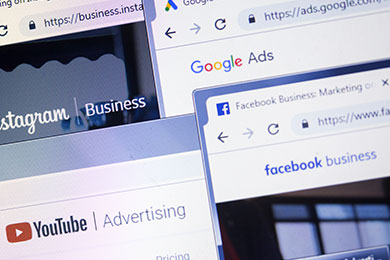Most of us use search engines to find a website that will help with a particular problem or offer the product we want. That’s why it’s so important for websites to achieve a good search ranking. In addition to search engine optimisation (SEO), an organic search strategy, there’s also SEA. Read on here to find out what exactly this means.

What is SEA?
SEA stands for search engine advertising, which is a form of search engine marketing. It normally involves placing text ads above, below or beside organic search results on Google, Bing, Yahoo and the like. Display banners on third-party websites also fall under SEA. Many website operators use Google Ads for this due to Google’s dominance in the search engine market.
How do SEA and SEO differ?
One of the big differences between SEA and SEO is that advertisers always have to pay for SEA. Therefore, search engine advertising is about short-term measures. Companies decide in advance on the keywords that should trigger their ads.
SEO, on the other hand, is a long-term strategy this is focused on the content of organic searches and achieving the best possible ranking in search engine results. Search engine algorithms rate the user-friendliness of a website, for example.
How does SEA work?
Essentially, SEA involves targeting particular keywords. This means that website operators determine in advance the keywords or keyword combinations for which their ad should appear.
As soon as a potential customer then clicks on their ad and is taken to the required page, the website operator (and advertiser in this instance) pays a fee. There is no cost for simply displaying the ad. Instead, a Cost Per Click (CPC) model is used.
With CPC, the more competition for a keyword, the higher the click price. For every search request, the search engine compares the CPC and quality of the keywords with all other ads. The maximum CPC and the quality score are then multiplied together in an auction. The ad with the highest score (ad rank) appears at the top of the advertisements.
In addition to the actual placement of the ad, however, SEA also requires some preparation and follow-up. For example, the texts have to be drafted and optimised, the budget determined, regional restrictions put in place and landing pages created. And if the placed ads don’t work as hoped, all of the steps have to be repeated.
What are the benefits of SEA?
SEA is generally a form of pull advertising. Potential customers are attracted through text ads, for example, by appealing to their needs. This gives SEA a crucial advantage over other forms of advertising: customers are not immediately irritated and inclined to click away. As the ads shown depend on a particular keyword, a customer is very likely to find a suitable solution on the promoted website.
Search engine advertising also makes it easier for advertisers to measure and analyse success and make improvements where necessary. In addition to having usually quick access to information on visible successes, advertisers achieve significant reach and high acceptance among customers.
Who should use SEA?
The size of a company is generally not a factor in the success of an SEA campaign. After all, SEA offers great potential for websites with specialised content. Given how search engine advertising works, the cost per click of an ad is determined by the competition, among other things. Therefore, ads on niche topics can be placed cheaply on search engines depending on the keyword.
When retailers or manufacturers in the paper and stationery industry begin using SEA, the most important thing to remember is that search engine advertising should be focused on where there is profit to be made, especially at the beginning. For example, they have the option to initially limit advertising to their main product or service.
Resource: Adapted from Internet
Post time: Jun-08-2022




